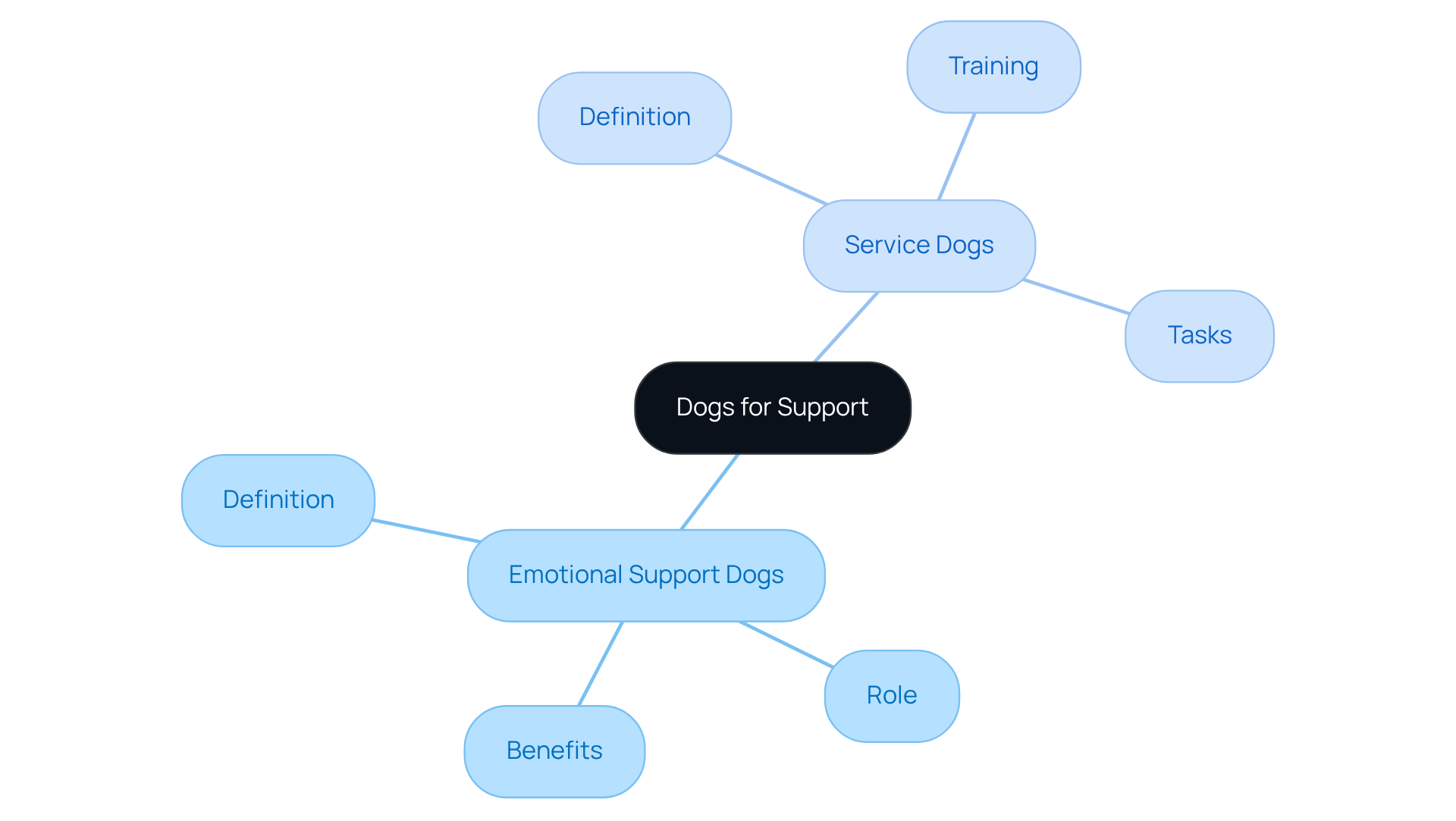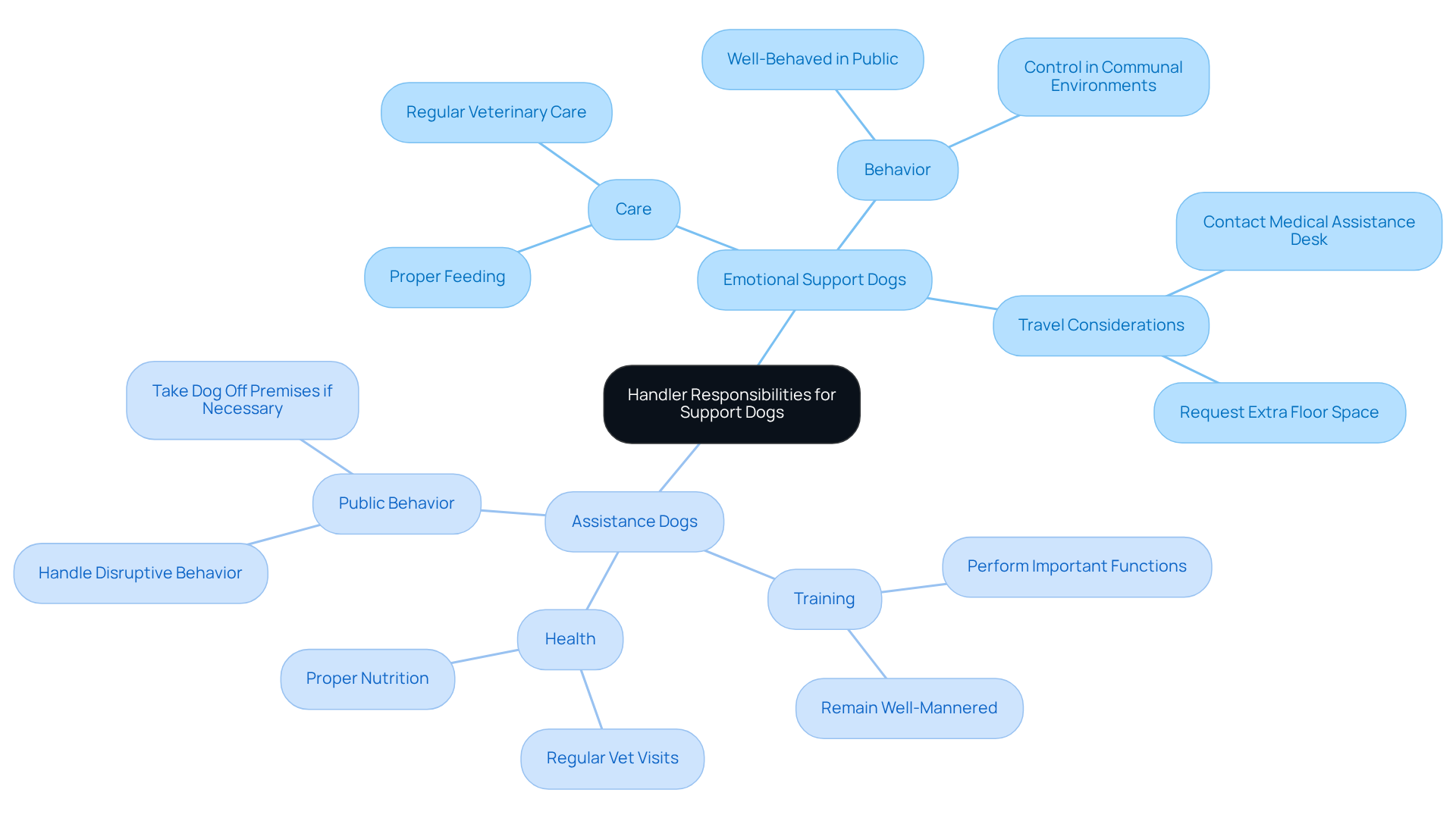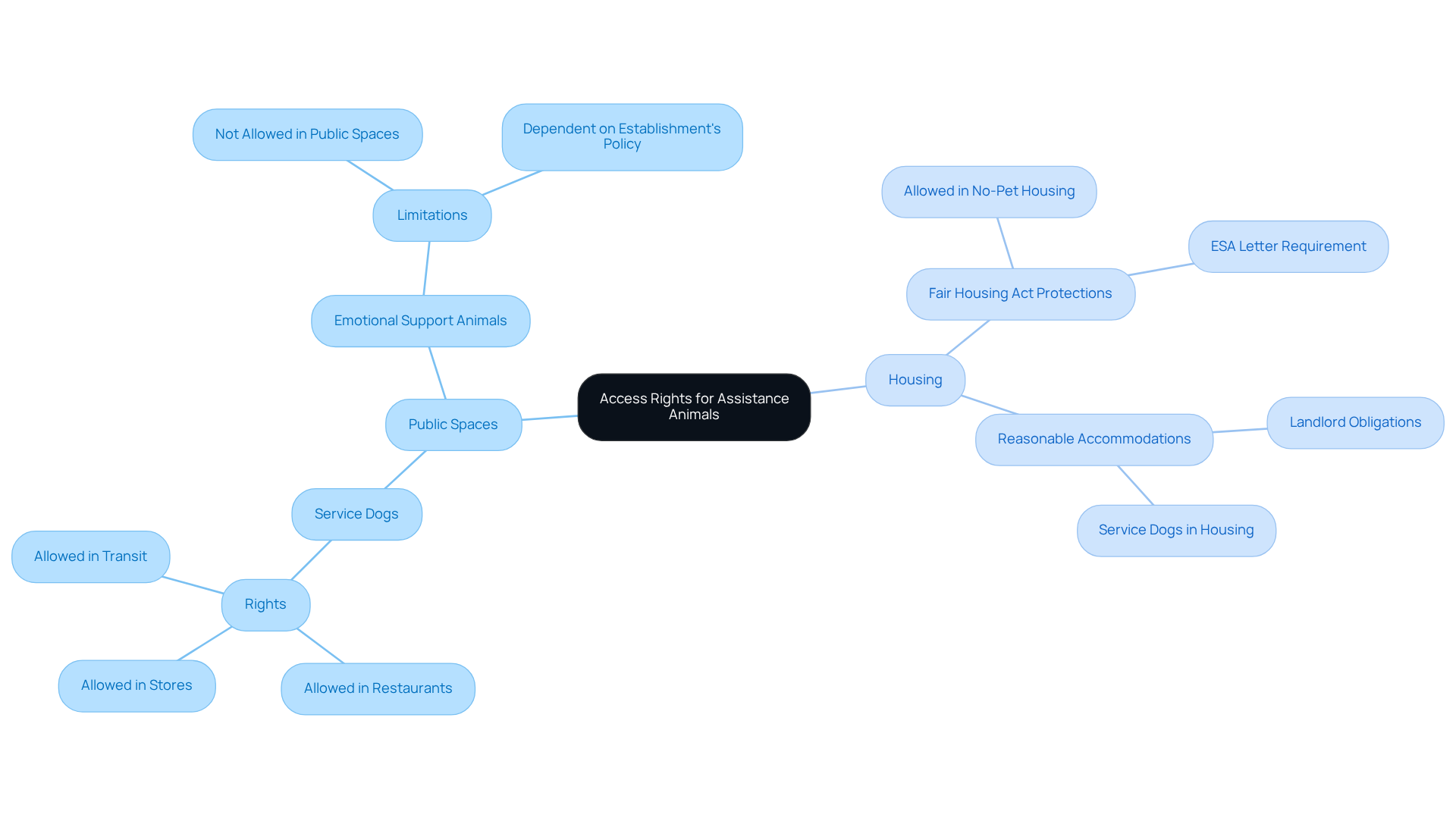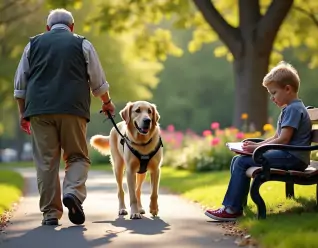

Difference Between Emotional Support Dog and Service Dog Explained
by Lena Park
Last updated: August 23, 2025
Verified and Approved by:
Angela Morris,
MSW, LCSW
Fact Checked

Overview
The primary distinction between an emotional support dog (ESD) and a service dog stems from their training and the specific tasks they undertake. ESDs are there to provide comfort and companionship, often without specialized training, while service dogs are expertly trained to assist individuals with disabilities through specific tasks.
This article highlights the importance of understanding this difference by noting that service dogs enjoy legal protections under the Americans with Disabilities Act (ADA), granting them access to public spaces. Unfortunately, ESDs do not share these same rights unless explicitly permitted by the establishment. Recognizing this can help you navigate your journey with emotional support animals more effectively.
Introduction
Understanding the roles of Emotional Support Dogs and Service Dogs is vital for anyone navigating the complexities of mental health and disability support. Many individuals face emotional challenges, feeling overwhelmed and isolated in their struggles. While both types of dogs offer invaluable companionship, their training and legal rights differ significantly, which can add to the confusion. Emotional Support Dogs provide comfort without specialized training, serving as a source of solace during difficult times. On the other hand, Service Dogs are equipped to perform specific tasks that assist individuals with disabilities, offering practical help in daily life.
What happens when the lines between these two types of support animals blur? It can be disheartening to feel uncertain about the support available to you. It’s essential to understand how each type of dog can meet your needs and provide the comfort you deserve. By recognizing the unique characteristics of Emotional Support Dogs and Service Dogs, individuals can ensure they receive the appropriate help they need. Remember, there is support out there, and you are not alone on this journey.
Define Emotional Support Dogs and Service Dogs
Emotional Support Dogs (ESDs) are beloved companions that provide comfort and emotional support to individuals navigating mental health conditions. Unlike assistance animals, ESDs do not require specialized training for specific tasks related to a disability. Instead, they offer companionship and help alleviate symptoms of anxiety, depression, and other emotional challenges that can feel overwhelming.
In contrast, Service Dogs are specially trained to perform specific tasks that assist individuals with disabilities. According to the Americans with Disabilities Act (ADA), a service dog is defined as a dog that has been individually trained to do work or perform tasks for a person with a disability. This training can encompass guiding individuals who are blind, alerting those who are deaf, pulling a wheelchair, or providing support during a seizure. The key distinction lies in the training and the tasks that these remarkable animals are equipped to perform.
Understanding the difference between emotional support dog and service dog can be crucial for those seeking the right kind of support. Emotional Support Dogs can bring warmth and companionship, helping to ease feelings of isolation and distress. If you or someone you know is struggling with mental health issues, consider the comforting presence of an ESD as a nurturing solution. Remember, you are not alone on this journey, and support is available.

Explore Legal Rights and Protections for Service Dogs
Assistance animals hold a special place in our hearts and are protected by the Americans with Disabilities Act (ADA), allowing them to accompany their owners in all public spaces, including restaurants, hotels, and public transit. It’s essential to understand that companies and institutions cannot deny access to assistance dogs based on breed or size, which can be a source of comfort for many. While caretakers are not required to provide documentation or proof of their dog’s training, obtaining certification from reputable organizations can enhance their credibility and ensure that the service dog has received the necessary training. It’s also important to remember that individuals cannot be questioned about their disabilities, fostering a respectful environment.
Service animals must remain under the control of their handler at all times, typically through a harness or leash. When these rights are infringed upon, it can lead to legal consequences for companies that refuse access. This highlights the significance of appropriate behavior around assistance animals, as it helps maintain their focus and effectiveness in supporting individuals with disabilities. By understanding these rights and responsibilities, we can create a more inclusive and compassionate society for everyone.

Outline Handler Responsibilities for Emotional Support and Service Dogs
Handlers of emotional support animals carry a heartfelt responsibility for the care and supervision of their beloved companions. This vital role includes ensuring that the dog is well-behaved, properly fed, and receives regular veterinary care. While emotional support dogs may not have the same access privileges as assistance dogs, it is essential for their owners to maintain control over them in communal environments, fostering a sense of safety and comfort for everyone involved.
For those who own assistance dogs, the duties extend further, encompassing the need to ensure that the dog is trained to perform its important functions and remains well-mannered in public. Handlers must also prioritize the dog’s health and well-being, which includes regular vet visits and proper nutrition. If an assistance dog behaves disruptively, it may be necessary for the handler to take the dog off the premises, a situation that can be distressing for both the handler and the animal.
Moreover, for individuals traveling with psychiatric assistance animals on Air Canada, it is crucial to reach out to the Medical Assistance Desk at least 48 hours prior to your flight. This proactive step allows you to inform them about your support animal and request any necessary extra floor space. You can call the Medical Assistance Desk at 800-667-4732. This thoughtful communication not only guarantees a smoother travel experience but also emphasizes the difference between emotional support dog and service dog, highlighting the importance of understanding their specific roles and responsibilities. Remember, you are not alone in this journey; support is available to help you navigate these challenges with compassion and care.

Examine Access Rights in Public Spaces and Housing
Assistance animals hold significant access rights under the ADA, allowing them to accompany their handlers in nearly all communal areas, such as restaurants, stores, and transit options. This is crucial for individuals who rely on these animals for support. However, the difference between emotional support dog and service dog is that emotional support animals do not share the same rights; they are not permitted in public spaces unless the establishment chooses to allow them. This distinction, particularly the difference between emotional support dog and service dog, can be disheartening for those who find comfort in their emotional support animals.
When it comes to housing, the Fair Housing Act offers vital protections for individuals with emotional support animals. This law allows them to reside in no-pet housing with an ESA letter, which can be a beacon of hope for those facing housing challenges. Landlords are required to make reasonable accommodations for these animals, even if they have a no-pets policy. Similarly, service dogs are permitted in housing situations, regardless of pet restrictions, ensuring that individuals have the support they need in their living environments.
Understanding the difference between emotional support dog and service dog can be empowering for those navigating the complexities of mental health challenges. The presence of an emotional support animal can provide comfort and companionship, making a significant difference in one’s quality of life. If you’re considering an emotional support animal, an ESA letter can be a supportive solution that opens doors to a more fulfilling life.

Conclusion
Understanding the distinction between Emotional Support Dogs (ESDs) and Service Dogs is essential for individuals seeking the right kind of support for their unique needs. While both types of dogs provide invaluable companionship, their roles, training, and legal protections differ significantly. ESDs offer emotional comfort without specialized training, whereas Service Dogs are specifically trained to perform tasks that assist individuals with disabilities, granting them access rights under the Americans with Disabilities Act (ADA).
Throughout this discussion, we recognize the emotional challenges faced by many. ESDs can alleviate feelings of loneliness and anxiety, providing a comforting presence, while Service Dogs perform critical tasks that enable individuals to navigate daily life with greater independence. It’s important to understand the responsibilities of handlers for both types of dogs, emphasizing the need for proper care and control in public settings.
Ultimately, understanding these differences empowers individuals to make informed decisions about support animals and fosters a more inclusive environment for everyone. Whether considering an Emotional Support Dog or a Service Dog, it is crucial to recognize their unique contributions to mental health and disability support. By advocating for awareness and respect for the rights of these animals and their handlers, we can move towards a more compassionate future that embraces the diverse needs of all individuals. Remember, you are not alone in this journey, and support is available to help you thrive.
Frequently Asked Questions
What is an Emotional Support Dog (ESD)?
An Emotional Support Dog (ESD) is a companion that provides comfort and emotional support to individuals dealing with mental health conditions. ESDs do not require specialized training for specific tasks but help alleviate symptoms of anxiety, depression, and other emotional challenges.
How do Emotional Support Dogs differ from Service Dogs?
The primary difference is that Emotional Support Dogs do not require specialized training for specific tasks, while Service Dogs are specially trained to perform tasks that assist individuals with disabilities, such as guiding the blind or alerting the deaf.
What does the Americans with Disabilities Act (ADA) say about Service Dogs?
According to the ADA, a Service Dog is defined as a dog that has been individually trained to do work or perform tasks for a person with a disability, which can include various supportive roles like guiding, alerting, pulling a wheelchair, or providing assistance during a seizure.
What role do Emotional Support Dogs play in mental health?
Emotional Support Dogs play a nurturing role by providing companionship and helping to ease feelings of isolation and distress for individuals struggling with mental health issues.
Can anyone benefit from having an Emotional Support Dog?
Yes, individuals experiencing mental health challenges may find the comforting presence of an Emotional Support Dog to be a valuable source of support.
Certify Your Emotional Support Animal Today

Why You Can Rely on Us?
At Wellness Wag, we believe your pet deserves care rooted in both science and compassion. Each article is carefully researched, written in clear language for pet owners, and then reviewed by qualified professionals to ensure the information is evidence-based, current, and practical for real-life care. Our goal is to help you feel confident in making informed decisions about your pet’s health and well-being.
Reviewed by
Angela Morris, MSW, LCSW
Angela is a licensed clinical social worker with 20 years of experience in patient advocacy and community mental health. She has assisted numerous clients with ESA evaluations and brings a deep understanding of disability accommodations, ensuring that all information is accurate, supportive, and practical.

Written by :
Lena Park
Last Updated :
August 23, 2025












